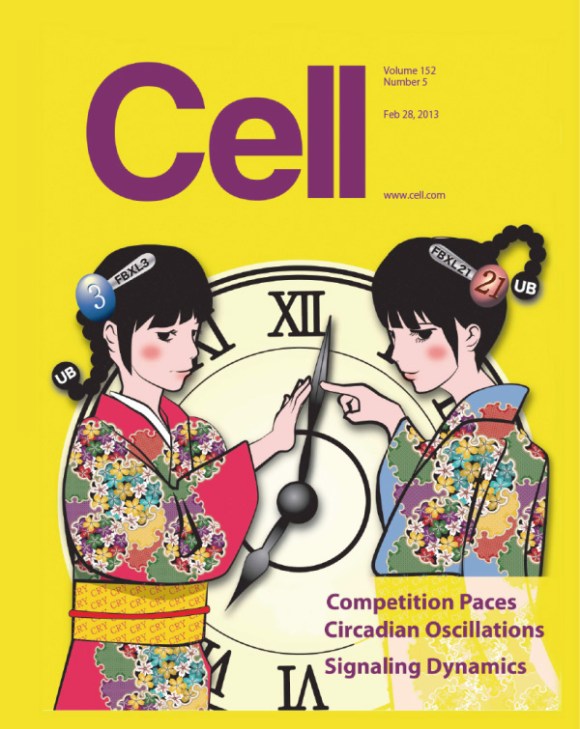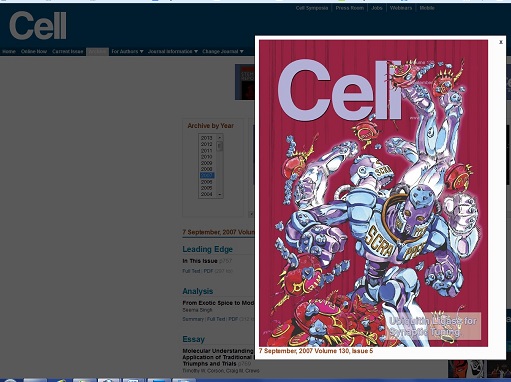
Take a good look at this cover for the 28 Feb. issue of noted science journal Cell. If you can tell me what this image means without reading the article then I’ll give you a shiny nickel!*
We see two young women wearing kimonos each with a hand on the minute hand of a giant clock. There are various letters and numbers printed on them, but what does it all mean?
The cover design is based on an article submitted by a research team from Tokyo University titled: FBXL21 Regulates Oscillation of the Circadian Clock through Ubiquitination and Stabilization of Cryptochromes.
Don’t worry, there’s simple summary to explain what that means.
“In the mammalian circadian clockwork, CRY1 and CRY2 repressor proteins are regulated by posttranslational modifications for temporally coordinated transcription of clock genes. Previous studies revealed that FBXL3, an F-box-type E3 ligase, ubiquitinates CRYs and mediates their degradation. Here, we found that FBXL21 also ubiquitinates CRYs but counteracts FBXL3. Surprisingly, FBXL21 stabilized CRYs and antagonized the destabilizing action by FBXL3.”
In English, that means our bodies have a type of built-in clock that runs on a 24-hour cycle conveniently matching one rotation of the Earth. This helps our bodies perform the best inner processes for what it expects us to be routinely doing (sleeping, working, etc).
This clock (often called a “circadian clock”) is managed by proteins called CRY. Two enzymes called FBXL21 and FBXL3 interact with the CRY proteins. These two enzymes are different in their structure and location of a protein called ubiquitin (Ub).
FBXL3 breaks down the CRY which moves our body’s sense of time forward. On the other hand, the FBXL21 preserves CRY and slows down its degradation caused by FBXL3. While FBXL3 drives the clock forward FBXL21 provides a little resistance. As a result this stabilizes our inner clock to a constant 24 hours.
Okay. Now you can look at the picture again.
The research is hoped to lead to treatments of disorders and diseases caused by abnormal body clocks.
Cell has used various talented people to design their covers over the years. This one was done by Yuki Takahashi. Another cover designed by a Japanese person was from the 7 Sept. 2007 issue done by the creator of JoJo’s Bizarre Adventure, Hirohiko Araki.
I would explain what this one means, but I’m suddenly very sleepy. For some reason reading scientific journals makes me really drowsy. Something must be wrong with my CRY proteins.
Source: Cell (English) via IT Media (Japanese)
Top Image: University of Tokyo
*Note: Payment of the shiny nickel will only be made when the winner finds me on the street and pulls a gun on me… Then I suppose you can have all the nickels you want.


 What makes a good boss in Japan? Workers sound off in survey
What makes a good boss in Japan? Workers sound off in survey Our team of five reporters try to turn themselves into Japanese heartthrob Kimutaku【Photos】
Our team of five reporters try to turn themselves into Japanese heartthrob Kimutaku【Photos】 Mr. Sato tries to make himself invisible by wearing mirror paper, creates cool modern art instead
Mr. Sato tries to make himself invisible by wearing mirror paper, creates cool modern art instead Japanese thug wear from Birth Japan perfect for those breaking bad next year
Japanese thug wear from Birth Japan perfect for those breaking bad next year Tokyo station platform to transform into sake bar with hot drinks, hot oden, and hot kotatsu
Tokyo station platform to transform into sake bar with hot drinks, hot oden, and hot kotatsu What makes a good boss in Japan? Workers sound off in survey
What makes a good boss in Japan? Workers sound off in survey Our team of five reporters try to turn themselves into Japanese heartthrob Kimutaku【Photos】
Our team of five reporters try to turn themselves into Japanese heartthrob Kimutaku【Photos】 Mr. Sato tries to make himself invisible by wearing mirror paper, creates cool modern art instead
Mr. Sato tries to make himself invisible by wearing mirror paper, creates cool modern art instead Japanese thug wear from Birth Japan perfect for those breaking bad next year
Japanese thug wear from Birth Japan perfect for those breaking bad next year Tokyo station platform to transform into sake bar with hot drinks, hot oden, and hot kotatsu
Tokyo station platform to transform into sake bar with hot drinks, hot oden, and hot kotatsu Japanese osechi New Year’s meal lucky bag gives us way more than we bargained for
Japanese osechi New Year’s meal lucky bag gives us way more than we bargained for It looks like fish, but does it taste like it? Imitation tuna almost breaks our minds 【Taste test】
It looks like fish, but does it taste like it? Imitation tuna almost breaks our minds 【Taste test】 Eating a shark heart from a Tokyo supermarket【Photos】
Eating a shark heart from a Tokyo supermarket【Photos】 Private booths are coming to Japan’s Shinkansen bullet trains even sooner than we’d thought【Video】
Private booths are coming to Japan’s Shinkansen bullet trains even sooner than we’d thought【Video】 Japanese beef bowl chain Sukiya’s 2026 Smile Box lucky bag basically pays for itself
Japanese beef bowl chain Sukiya’s 2026 Smile Box lucky bag basically pays for itself Starbucks Japan ready to get Year of the Horse started with adorable drinkware and plushies【Pics】
Starbucks Japan ready to get Year of the Horse started with adorable drinkware and plushies【Pics】 Hayao Miyazaki says Happy New Year to Studio Ghibli fans with new art for Year of the Horse
Hayao Miyazaki says Happy New Year to Studio Ghibli fans with new art for Year of the Horse Cup Noodle tries an authentic Jiro-style ramen, but something’s not quite right
Cup Noodle tries an authentic Jiro-style ramen, but something’s not quite right The best Starbucks Japan Frappuccinos we want to drink again in 2026
The best Starbucks Japan Frappuccinos we want to drink again in 2026 We revisited Sweets Paradise after a decade to see if Japan’s dessert buffet still delivers
We revisited Sweets Paradise after a decade to see if Japan’s dessert buffet still delivers That time Seiji called JASRAC to ask why he didn’t get paid royalties for his song being on TV
That time Seiji called JASRAC to ask why he didn’t get paid royalties for his song being on TV We found possibly the quietest Japanese-style hotel in Tokyo’s bustling Shinjuku district
We found possibly the quietest Japanese-style hotel in Tokyo’s bustling Shinjuku district Pizza Hut Japan’s hot lucky bags are perfect for a New Year’s pizza party
Pizza Hut Japan’s hot lucky bags are perfect for a New Year’s pizza party Japan’s oldest largetooth sawfish in captivity back on display in Mie Prefecture
Japan’s oldest largetooth sawfish in captivity back on display in Mie Prefecture 7-Eleven Japan starts new temporary luggage storage service in over 300 branches
7-Eleven Japan starts new temporary luggage storage service in over 300 branches Disillusionment at Tsukiji’s tourist-target prices led us to a great ramen restaurant in Tokyo
Disillusionment at Tsukiji’s tourist-target prices led us to a great ramen restaurant in Tokyo Starbucks teams up with 166-year-old Kyoto doll maker for Year of the Horse decorations【Photos】
Starbucks teams up with 166-year-old Kyoto doll maker for Year of the Horse decorations【Photos】 Tokyo considering law requiring more trash cans following litter increase in heavily touristed area
Tokyo considering law requiring more trash cans following litter increase in heavily touristed area Tokyo’s Tsukiji sushi neighborhood asks tour groups to stay away for the rest of the month
Tokyo’s Tsukiji sushi neighborhood asks tour groups to stay away for the rest of the month Tokyo event lets you travel back in time, for free, to celebrate 100 years since Showa era start
Tokyo event lets you travel back in time, for free, to celebrate 100 years since Showa era start Japan may add Japanese language proficiency, lifestyle classes to permanent foreign resident requirements
Japan may add Japanese language proficiency, lifestyle classes to permanent foreign resident requirements Sanrio theme park in Japan announces plans to expand into a Sanrio resort
Sanrio theme park in Japan announces plans to expand into a Sanrio resort Stamina-destroying “Paralysis Noodles” are Tokyo’s newest over-the-top ramen innovation
Stamina-destroying “Paralysis Noodles” are Tokyo’s newest over-the-top ramen innovation Survey asks foreign tourists what bothered them in Japan, more than half gave same answer
Survey asks foreign tourists what bothered them in Japan, more than half gave same answer Japan’s human washing machines will go on sale to general public, demos to be held in Tokyo
Japan’s human washing machines will go on sale to general public, demos to be held in Tokyo Japan’s deadliest food claims more victims, but why do people keep eating it for New Year’s?
Japan’s deadliest food claims more victims, but why do people keep eating it for New Year’s? We deeply regret going into this tunnel on our walk in the mountains of Japan
We deeply regret going into this tunnel on our walk in the mountains of Japan Studio Ghibli releases Kodama forest spirits from Princess Mononoke to light up your home
Studio Ghibli releases Kodama forest spirits from Princess Mononoke to light up your home Major Japanese hotel chain says reservations via overseas booking sites may not be valid
Major Japanese hotel chain says reservations via overseas booking sites may not be valid Put sesame oil in your coffee? Japanese maker says it’s the best way to start your day【Taste test】
Put sesame oil in your coffee? Japanese maker says it’s the best way to start your day【Taste test】 No more using real katana for tourism activities, Japan’s National Police Agency says
No more using real katana for tourism activities, Japan’s National Police Agency says Starbucks Japan reveals new sakura drinkware collection, inspired by evening cherry blossoms
Starbucks Japan reveals new sakura drinkware collection, inspired by evening cherry blossoms Updated cherry blossom forecast shows extra-long sakura season for Japan this year
Updated cherry blossom forecast shows extra-long sakura season for Japan this year Japanese osechi New Year’s meal lucky bag gives us way more than we bargained for
Japanese osechi New Year’s meal lucky bag gives us way more than we bargained for It looks like fish, but does it taste like it? Imitation tuna almost breaks our minds 【Taste test】
It looks like fish, but does it taste like it? Imitation tuna almost breaks our minds 【Taste test】 Eating a shark heart from a Tokyo supermarket【Photos】
Eating a shark heart from a Tokyo supermarket【Photos】 Private booths are coming to Japan’s Shinkansen bullet trains even sooner than we’d thought【Video】
Private booths are coming to Japan’s Shinkansen bullet trains even sooner than we’d thought【Video】 Japanese beef bowl chain Sukiya’s 2026 Smile Box lucky bag basically pays for itself
Japanese beef bowl chain Sukiya’s 2026 Smile Box lucky bag basically pays for itself Is One Piece’s end in sight? Editor reveals final arc is mapped out, speculates on timetable
Is One Piece’s end in sight? Editor reveals final arc is mapped out, speculates on timetable In Hokkaido there’s weed, weed everywhere, but not a drop to smoke
In Hokkaido there’s weed, weed everywhere, but not a drop to smoke Japanese people give their thoughts on Gaijin Hunters/English Vampires
Japanese people give their thoughts on Gaijin Hunters/English Vampires World’s only double-helix wooden structure, Aizu Sazaedo, is mysterious both outside and inside
World’s only double-helix wooden structure, Aizu Sazaedo, is mysterious both outside and inside A heartwarming tale of mistaken Japanese train groping
A heartwarming tale of mistaken Japanese train groping Things get heavy with the Gold Lucky Bag from Village Vanguard
Things get heavy with the Gold Lucky Bag from Village Vanguard Top Japanese cosplayer Enako returns to Comiket after 6 years, creates mayhem with admirers
Top Japanese cosplayer Enako returns to Comiket after 6 years, creates mayhem with admirers
Leave a Reply